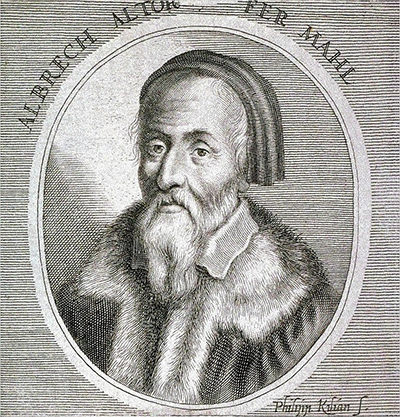Albrecht Altdorfer was a skilled artist who produced highly respected paintings, drawings and etchings in the early part of 16th century Germany.
Unique Compositions
He is most famous for his breathtaking landscape scenes featuring large numbers of carefully crafted figures. This approach created something of a brand for his career, and makes a number of his paintings instantly recognisable as his own. That said, this approach will also remind many of the work of Pieter Bruegel, Hendrick Avercamp and Hieronymus Bosch, whose styles bear some similarities in composition.
This famous artist played a key role in the advancement of Northern Renaissance art and, in particular, landscape painting. Depictions of nature had always been used as supporting elements to larger compositions before artists such as this promoted it as a worthy art form which should be respected as an independent art form in its own right.
Role of his Father
A young Albrecht would take inspiration from his father, also an artist, and this influence set him along a path that ultimately would lead to him being a key member of the Danube School, a significant strand of the Northern Renaissance. It also counted Lucas Cranach the Elder and Wolf Huber within its ranks. At this time German artists were playing an important role supporting the great masters of the Netherlandish regions in strengthening the impact of this part of Europe's contribution to an important time in artistic development across the whole continent.
Variation in his Use of Figurative Art
Whilst some of Albrecht Altdorfer's paintings, such as The Battle of Alexander at Issus, featured a whole plethora of complex scenes of crowds of figures, the majority of his work was actually much simpler, sometimes relying purely on the landscape skills of this groundbreaking painter. He would continue this into the mediums of drawing, etching and woodcuts too. Most significantly, this artist is considered to be the first of the modern landscape painters, promoting this genre at a time when others dominated with allegorical depictions or half-length portraits of monarchs and noblemen.
Artistic Influences
Lucas Cranach, born just a few years earlier than Albrecht, is known to have inspired his use of landscapes (Albrecht's brother, Erhard, served under this great master). It was Altdorfer who took things further, in some of his artworks, and significantly reduced, even removing completely, the role of humanity within some of these scenes. In a similar manner to the much later Hudson River School, he respected the natural world and considered humans to be encroaching on this beauty.
We see examples of these sprawling, monumentous landscapes in the likes of The Battle of Alexander at Issus, but in many works he used the more traditional formats akin to traditional Italian and north European art, with a selection of figures in the foreground, and rolling hills supporting the background in a less impactful manner.
Bright Palette
An aspect of his paintings which particularly stands out when compared to other oeuvres from this period, in his choice of colours. Whilst some of his landscape scenes can be dark in tone, most of his more complex pieces feature bright colours which were unusual for the period. The same could be said for Cranach too, and this brightness feels contemporary when viewed through modern eyes.
Additional Employment
The artist kept himself busy by taking on multiple mediums across his career, also achieving success as a printmaker which brought additional funds into his studio. Despite these commitments, he was still able to also work as an architect and local politician. His region of Bavaria was going through a turbulent time and the artist wanted to bring a level of intelligence and calm to proceedings, though these positions would also have allowed him to promote his work too.
Workshop
The general concensus is that Altdorfer built up a large studio as his reputation started to spread. His brother is likely to have been a part of it after his apprenticeship under the wing of Cranach. It would have been an exciting studio to be a part of, with etching, drawing and painting being used alongside elements of architecture which the master liked to incorporate into elements of his paintings.
Legacy
It is the sprawling landscapes with huge numbers of figures in frenetic scenes which first attracts people to the work of Altdorfer, and normally his legacy is over shadowed by two great German masters, namely Cranach and Durer. To fall behind them should not detract from his own achievements, spread across different mediums and disciplines. His strongest legacy is regards landscape art, and respected the environment around us, and realising that art does not have to have any human involvement, necessarily.




